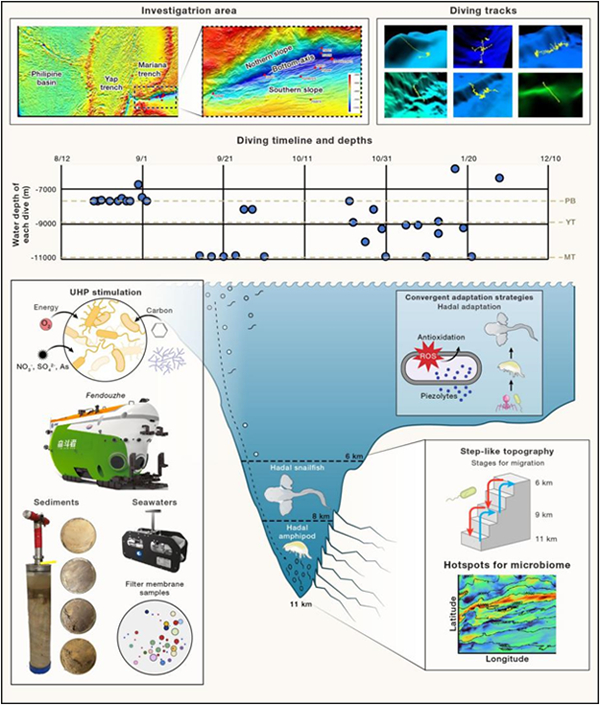Supported by the NSFC Major Research program "Mechanisms Underlining Elemental Cycling on the Earth by Microorganisms in the Hydrosphere," a team led by Professor Xiang Xiao from Shanghai Jiao Tong University, in collaboration with the Institute of Deep-Sea Science and Engineering (IDSSE) of the Chinese Academy of Sciences and BGI Group, has launched the Mariana Trench Environment and Ecology Research (MEER) Project. Significant progress has been made in the study of hadal ecosystems, with findings published as the flagship article of a special collection in Cell on March 7, 2025, titled "MEER: Extraordinary Flourishing Ecosystem in the Deepest Ocean." The paper can be accessed at: http://www.cell.com/cell/fulltext/S0092-8674(24)01480-6.
The hadal zone, defined as ocean depths exceeding 6,000 meters, represents the endpoint of tectonic plate subduction and serves as a conduit connecting the ocean to Earth's deep interior. Its unique ecosystems and extreme biological processes play an irreplaceable role in global change. Due to its inaccessibility, the hadal zone remains one of the least explored extreme environments on Earth, with multiple international hadal research projects failing since 1960. The MEER project, leveraging China's independently developed Human-Occupied Vehicle (HOV) "Fendouzhe," has overcome the challenges of sampling and experimentation under extreme high-pressure conditions, establishing a comprehensive research model encompassing "deep-sea sampling, gene sequencing, data analysis, and laboratory validation," and completed the world's first systematic study of hadal ecosystems.
From August to December 2021, the research team collected over 2,000 samples of water, sediment, and macroorganisms from depths of 6,000 to 10,900 meters in the Mariana Trench, Yap Trench, and Philippine Basin. The study provides the first panoramic view of the hadal ecosystem, revealing the extraordinary taxonomic novelty and diversity of hadal microorganism under ultra-high hydrostatic pressures (600-1,090 times atmospheric pressure) in the deepest ocean. It addresses key scientific questions, such as the origins of the high novelty and diversity of hadal microbial communities, and how hadal microorganims and macroorganisms (both invertebrate and vertebrate) adapt to the hadal extreme environment. The team discovered convergent adaptive mechanisms between two representative hadal macroorganisms and hadal microorganims, such as enhanced antioxidation capacity and accumulation of intracellular compatible solutes. These findings suggest the existence of "Convergent Adaptation" strategies across species and biological domains in the hadal environment.
The achievements of the MEER project extend the boundaries of human understanding of life to the 10,000-meter hadal zone, bridging a critical gap in the global marine ecological map. The exceptional novelty and diversity of hadal microorganisms also highlight their potential as a valuable resource for new genes, structures, and functions, offering new possibilities to address the depletion of conventional environmental biological resources in recent decades.

Figure. Information on dives and sampling from the MEER project and its main scientific findings.

Add: 83 Shuangqing Rd., Haidian District, Beijing, China
Postcode: 100085
Tel: 86-10-62327001
Fax: 86-10-62327004
E-mail: bic@donnasnhdiary.org
京ICP备05002826号 文保网安备1101080035号 Copyright 2017 NSFC, All Right Reserved